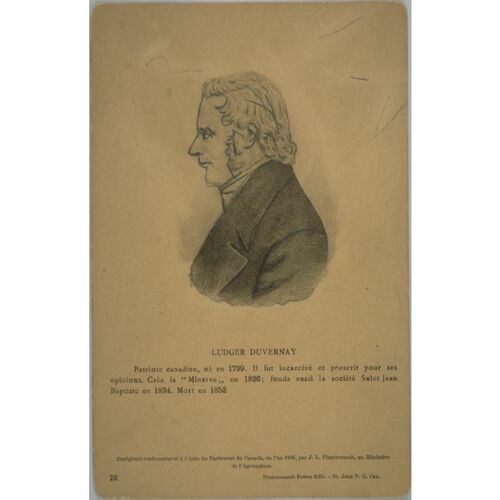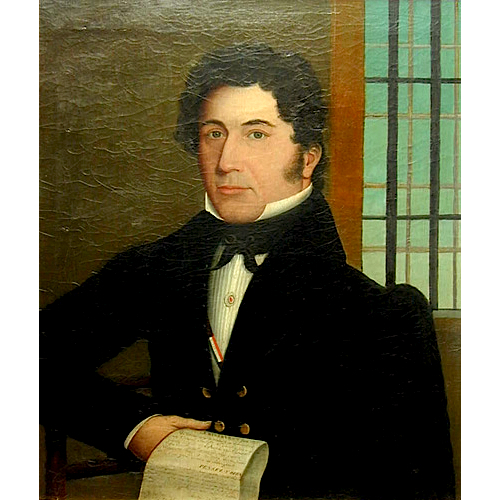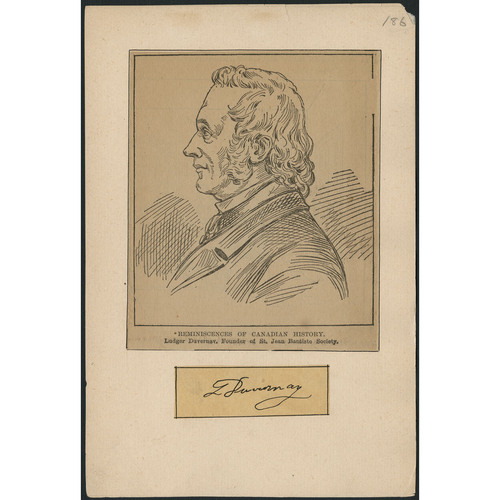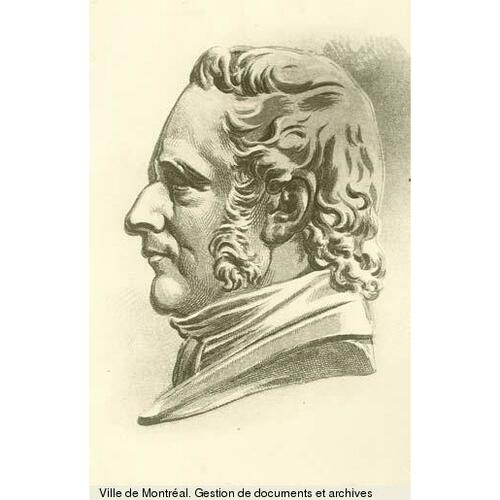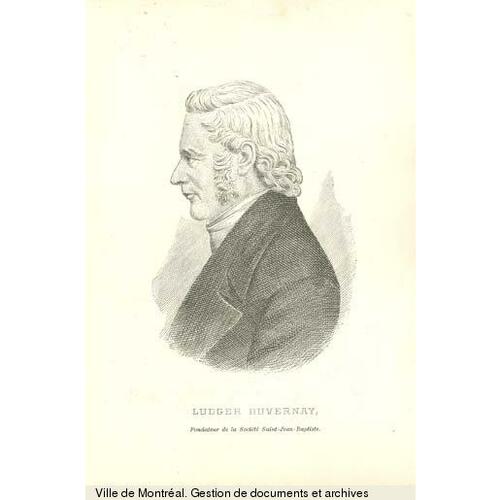As part of the funding agreement between the Dictionary of Canadian Biography and the Canadian Museum of History, we invite readers to take part in a short survey.
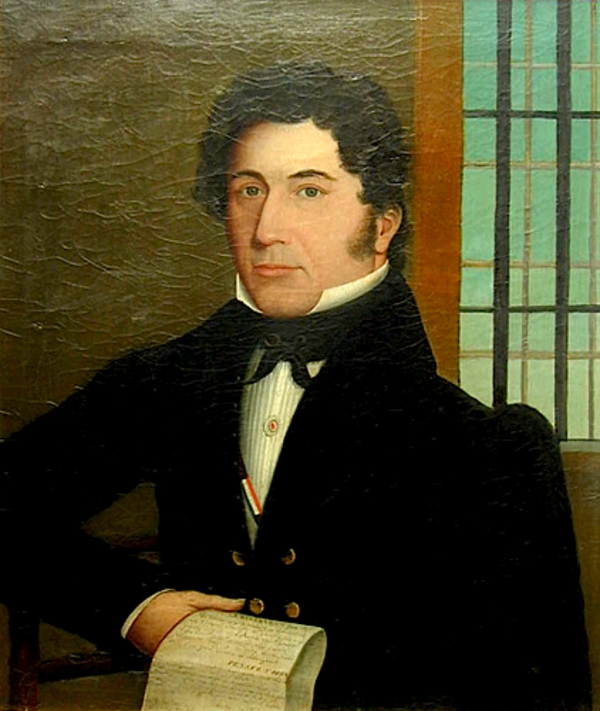
Source: Courtesy of Wikimedia Commons
DUVERNAY, LUDGER (baptized Joseph-Ludger), printer, newspaperman, office holder, politician, and Patriote; b. 22 Jan. 1799 in Verchères, Lower Canada, son of Joseph Crevier Duvernay and Marie-Anne-Julie Rocbert de La Morandière; d. 28 Nov. 1852 in Montreal.
Ludger Duvernay’s forebear Christophe Crevier, a native of Normandy, immigrated to New France in the mid 17th century and settled at Trois-Rivières. His son, Jean-Baptiste Crevier, adopted the surname Duverné, which with time became Duvernay. On 26 June 1748 his grandson Jacques Crevier Duvernay was granted a commission as royal notary by the intendant Gilles Hocquart* authorizing him to practise in the côtes of Verchères, Varennes, Saint-Ours, and along the Rivière Chambly (Rivière L’Acadie). One of Jacques’s brothers, Pierre Crevier Duvernay, also served as a royal notary in 1762. One of Jacques’s sons, Ludger’s father Joseph, was a master carpenter at Verchères. Joseph drowned on 21 Aug. 1820 while crossing the St Lawrence from a point opposite Saint-Sulpice. Ludger’s mother was descended from an illustrious family. Her father, François-Abel-Étienne Rocbert de La Morandière, who had been a lieutenant in the colonial regulars, captain of a battalion dispatched against Pontiac*, and military engineer, was the grandson of Étienne Rocbert* de La Morandière, the keeper of the king’s stores at Montreal in the early decades of the 18th century.
Ludger is thought to have had the advantage of being taught by schoolmaster Louis Labadie*, who, after teaching in various villages in Lower Canada, ran a school at Varennes, near Verchères, from 1805. Some of his pupils came from the neighbouring parishes and boarded near his school. In 1813 Labadie took up residence in Verchères, where with keen interest he followed Duvernay’s first steps in the printing world. On 3 June Le Spectateur of Montreal, owned by Charles-Bernard Pasteur, advertised for an apprentice for its printing house: “a young boy well brought up and of a respectable family” able to “read and write the French language.” Duvernay, who was then 14, applied and was selected. The young apprentice proved reliable and diligent. A resident of Verchères assured his parents that their son reasoned “not like a parrot but like a man of good sense.” He finished his apprenticeship in 1815 and, with Labadie’s support, became an employee of the Pasteur printing house. Labadie had strongly advised Duvernay to make a career in printing, emphasizing that “in this calling you could not fail to be an enlightened man.” Duvernay won Pasteur’s confidence and held an increasingly important place within the establishment. It was Duvernay who was entrusted with running the business when his employer was away.
Duvernay left Montreal in 1817 to open his own printing house at Trois-Rivières. He is thought to have chosen this spot because of the lack of competition there, and he was probably urged on by Denis-Benjamin Viger*, who was helping printers and newspaper owners by providing financial assistance and renting them premises. On 12 August, with some degree of recklessness, he launched La Gazette des Trois-Rivières, the first Lower Canadian newspaper to be published outside Quebec and Montreal. The first issue attracted a crowd to the doors of the shop, and Duvernay received many flattering comments. He had previously outlined the responsibilities of a newspaper in his prospectus for La Gazette des Trois-Rivières. A “periodical paper” should on the one hand stress and praise “good actions” but on the other should denounce oppression “so as to arouse [the] salutary fear that gives support and protection to the weak by acting as a brake upon the ill-intentioned.” He declared also that he would do his utmost to publish literary works in order to enliven “the seriousness of business with the pleasures of literature.” Throughout his career as a publisher, Duvernay deviated little from this approach. La Gazette des Trois-Rivières is thought to have ceased publication in February 1821.
Duvernay had also published, from June to September 1820, a religious monthly, L’Ami de la religion et du roi, of which the unofficial editor was the priest of the parish of Trois-Rivières, Louis-Marie Cadieux*. Jean Raimbault*, the curé of Nicolet and superior of the local seminary, also contributed to the newspaper, and the numerous royalist priests in the Trois-Rivières region, who had been exiled from France after the revolution, publicized it. On 11 March 1823 Duvernay began publishing Le Constitutionnel, a newspaper which in presentation and content resembled the defunct Gazette des Trois-Rivières. It is believed to have lasted until the autumn of 1824. Despite his fruitless attempts, Duvernay persevered in trying to keep a newspaper going at Trois-Rivières. In August 1826 he took advantage of a by-election in the riding of Trois-Rivières to launch another one. L’Argus appeared for three months, and as its subtitle, “journal électorique,” indicates, its contents were mainly devoted to the progress of the campaign. Its editors, brothers Dominique* and Charles-Elzéar* Mondelet, supported candidate Pierre-Benjamin Dumoulin, but he was unsuccessful.
At his establishment on Rue Royale, Duvernay also printed a few books and pamphlets and maintained a small bookstore as well as a bindery. Even though he was young, he had soon begun to play an important part in the affairs of Trois-Rivières. He was the superintendent of highways and the inspector of bridges and roads for the town. He was also inspector of the Fire Society from 1819 to 1826. During his years in Trois-Rivières, in addition to familiarizing himself with the various aspects of the printer’s trade, Duvernay showed initiative and a sense of organization. But Trois-Rivières did not yet have the resources to sustain a newspaper and its printer.
In December 1826 Duvernay was approached by the Canadian Spectator of Montreal, which had been without a printer since the departure of John Jones. Duvernay accepted the offer and was back in Montreal by the beginning of January 1827. On 18 January, in the presence of notary Jean-Marie Mondelet*, he signed an agreement to print the paper, which was intended particularly for the Irish in the Montreal region, and to rent Jean-Dominique Bernard’s printing workshop on Rue Saint-Jean-Baptiste. On the same day he purchased for £7 10s. 0d. La Minerve, a newspaper which had been launched on 9 Nov. 1826 by Augustin-Norbert Morin*, when he was a law student. Morin had stopped publishing the paper on 29 November because of a lack of subscribers, but at the time of its sale he promised to remain editor for six more months. In December 1828 Jocelyn Waller*, the publisher and editor – and moving spirit – of the Canadian Spectator, died. Duvernay took his place as editor, continuing to ensure the paper was printed, until its demise in February 1829. In August he acquired the printing house of James Lane, at the corner of Rue Saint-Paul and Rue Saint-Gabriel, where he remained until 16 Nov. 1837. La Minerve was thus produced in the heart of the business quarter in Montreal, and it supplied the various kinds of printed material useful to businessmen, members of the liberal professions, and officials. From 1829 to 1837 Duvernay was the principal producer of books and pamphlets in the city. School textbooks, devotional works, and political pamphlets were printed on the newspaper’s presses. A number of printing and sales agreements linked Duvernay and bookseller Édouard-Raymond Fabre. The almanacs of La Minerve, with a print run of several thousand copies per issue, were sold by rural merchants in the Trois-Rivières and Montreal regions. Other than devotional manuals, the almanac was often the only book that most of the rural population and city dwellers could afford to buy. In 1836 and 1837 a work that Duvernay had reprinted without authorization at the suggestion of Amury Girod* stirred up a great deal of controversy. The book, Les paroles d’un croyant by Félicité-Robert de La Mennais, had been published in Paris in 1834 and condemned by Pope Gregory XVI the same year. The Patriotes used the work of La Mennais to justify their struggles. Bishop Jean-Jacques Lartigue*, auxiliary bishop at Montreal and a long-time disciple of La Mennais, opposed the dissemination of the book in compliance with the pope’s decision.
Under Duvernay’s leadership La Minerve soon gained recognition as one of the principal newspapers of Lower Canada. At the time he purchased it in 1827, it had 240 subscribers, and by 1832 there were about 1,300, a respectable circulation for the period. According to Morin, it had become “the national newspaper.” As a supporter of the ideas of the Patriote party, Duvernay had placed his paper at the service of this political group. La Minerve had the benefit of financial assistance from Viger and Fabre. Duvernay himself seldom wrote for it, being content to contribute occasional short news items on various topics. However, when he considered himself under attack, he could produce scathing pieces. Antoine Gérin-Lajoie*, who was employed for two years in the office of La Minerve, acknowledged that Duvernay was very effective at “crushing someone through insults [and] offensive personal remarks.” However, he usually left it to a member of the staff to defend the paper’s views. Morin remained as editor longer than the six months originally agreed upon, but after he was elected to the House of Assembly for Bellechasse in October 1830, he had less and less time to devote to the paper, and Léon Gosselin* may be considered its real editor from 1831 to 1834. After that Hyacinthe-Poirier Leblanc* de Marconnay, James Julien Theodore Phelan, Gérin-Lajoie, and Raphaël Bellemare served successively as Duvernay’s editors. A very demanding man, Duvernay constantly imposed his own point of view, and he quarrelled frequently with his employees. Gosselin, Leblanc de Marconnay, and Phelan all left the establishment on bad terms with him. The salaries he paid were low or downright meagre. If someone complained, Duvernay accused him of wanting to accumulate money at his expense. In Gérin-Lajoie’s words, “To put anything by or to economize was a foolish, indeed a monstrous thing to him.”
As the articles in La Minerve and the Canadian Spectator were usually anonymous, it was Duvernay who assumed responsibility for them. On 18 Dec. 1827 he was arrested and put in jail, along with Waller of the Canadian Spectator, on a charge of libel. In January 1832 Duvernay and Daniel Tracey*, the publisher of the Vindicator (later the Vindicator and Canadian Advertiser), were summoned before the bar of the Legislative Council of Lower Canada, accused of having maintained that the council was a “great nuisance.” The two guilty parties were reprimanded by the speaker, Jonathan Sewell*, and kept in the jail at Quebec until the end of the session. This second imprisonment of Duvernay incensed the Patriote press and made a hero and martyr of him. When he was released, he received congratulations in numerous villages on his way back to Montreal. In that city triumphal arches had been erected in his honour. He was presented with a medal bearing the inscription, “The freedom of the press is the palladium of the people.” But in 1836 he was once again behind bars. In March of that year La Minerve had accused the sheriff, Louis Gugy*, of appointing a jury favourable to a jailer charged with responsibility for the death of a prisoner who had succumbed to privation and cold in the Montreal jail. Duvernay was prosecuted for contempt of court and in September was sentenced to 30 days’ imprisonment. He was led to jail in an impressive triumphal procession of Patriotes which included the mayor of Montreal, Jacques Viger.
A few months earlier Duvernay had defended the honour of his newspaper in a duel with lawyer Clément-Charles Sabrevois* de Bleury, who had been elected as a Patriote to represent Richelieu in 1832. When he was severely attacked by La Minerve for leaving the Patriote party and later joining the more moderate members from the Quebec region, Sabrevois de Bleury challenged the proprietor to a duel. The encounter took place on 5 April 1836 behind Mount Royal. The lawyer, a militia officer who was a skilful shot, wounded Duvernay just above the right knee. “The blood he was determined to shed,” retorted Duvernay in La Minerve two days later, “does not efface what has been written, and saltpetre and sulphur do not whiten what is black!”
In March 1834 Duvernay had joined with George-Étienne Cartier*, Louis-Victor Sicotte*, and other Patriotes in founding the society called Aide-toi, le Ciel t’aidera (God helps those who help themselves), and had been elected its president. Every member of the secret society was to produce and read an essay on politics or literature. Duvernay then conceived the idea of giving French Canadians an annual patriotic festival to be celebrated on 24 June. From ancient times, the summer solstice had been an occasion for rejoicing. The church had taken over this pagan celebration, transforming it into the feast of St John the Baptist. A “Midsummer Night’s bonfire” had been held in New France as early as 1646, and the custom of celebrating Saint-Jean-Baptiste Day had been carried on, particularly in the Lower Canadian parishes dedicated to Saint-Jean (Saint-Jean-Port-Joli, Saint-Jean on the Île d’Orléans, and others), before Duvernay decided to make it a French Canadian national festival. He saw to the preparations for a banquet that took place on 24 June 1834 in the garden of lawyer Jean-François-Marie-Joseph MacDonell*’s property (now the site of Windsor Station). Nearly 60 guests, including several influential members of the Patriote party, joined in the celebration, which was primarily a political demonstration. Some time earlier the Patriote party had adopted the 92 Resolutions, and it was gradually becoming more aggressive towards the government of the colony. Those attending the banquet paid tribute to the people, the “primary source of all legitimate authority,” and to the reformers of Lower and Upper Canada and of Ireland. They gathered around Duvernay again in 1835, 1836, and 1837. The rebellion was to interrupt this custom for a few years.
Duvernay had long wanted to make a career in politics but had never had the opportunity. He ran in a by-election for Rouville in February 1833 but was defeated by François Rainville. Several people dissuaded him from standing at the general election of November 1834 because he was then thought to be much more useful at the helm of La Minerve. He himself insisted on being allowed to run in 1837, and was elected by acclamation for Lachenaie on 26 May. The session began on 18 August but was prorogued on the 26th by the governor, Lord Gosford [Acheson*], who was unhappy about the attitude of the members belonging to the party of Louis-Joseph Papineau*. Hence Duvernay sat in the assembly for only a few days.
During the autumn of 1837 recourse to arms by the Patriotes appeared increasingly likely and indeed inevitable. On 23 October more than 5,000 people attended the Assemblée des Six Comtés at Saint-Charles-sur-Richelieu. On the evening of 6 November there was a violent confrontation in Montreal between members of the Doric Club and the Fils de la Liberté. The printing house of the Vindicator and Canadian Advertiser, the Patriote newspaper then under the editorship of Dr Edmund Bailey O’Callaghan*, was sacked and Duvernay’s establishment was threatened with a similar fate. On 16 November Lord Gosford issued warrants for the arrest of 26 influential Patriotes including Duvernay. Duvernay had been warned that his arrest was imminent and had fled by the time the bailiffs made their appearance at the printing house of La Minerve. Before leaving Montreal he entrusted his newspaper to Phelan and to the printer François Lemaître, but only one issue came out after his departure.
Duvernay was appointed an officer of a small Patriote battalion and took part in the battle of Moore’s Corner (Saint-Armand-Station) on 6 Dec. 1837. The Patriotes, who were too few in number to face up to their adversaries, abandoned their two cannons and their rifles and fled. Duvernay found refuge in the United States, where he lived in turn at Swanton and St Albans, Vt, Rouses Point, N.Y., and Burlington, Vt. Although he encountered numerous difficulties in obtaining the necessary printing equipment, he managed to start a newspaper at Burlington in 1839. “We declare in advance that we shall spare no one,” he announced in a prospectus. The first issue of Le Patriote canadien came out on 7 August. One of Papineau’s sons, Louis-Joseph-Amédée, contributed a few articles to the paper. As he did not receive authorization from the new governor, Charles Edward Poulett Thomson*, to distribute his paper by mail in Lower Canada and as the exiles were poor, scattered, and dwindling in number, Duvernay was forced to cease publication on 5 Feb. 1840. Exile then became harder and harder for him to bear. He had always been partial to liquor and now began to drink to excess. “I sometimes consign to the devil the whole business of politics and all those who have plunged us into this abyss,” he confided to his Montreal colleague, printer Louis Perrault*, who had returned to Lower Canada from exile the year before. During the summer of 1840 he even considered going to work for the American Board of Customs. At the beginning of May 1841 Ignace Bourget*, the bishop of Montreal, travelling to New York, met him at Burlington. As spokesman for the exiles, Duvernay requested that French Canadian priests be sent to minister to them. The bishop replied that he was edified by the religious sentiments of Duvernay, who prior to the rebellion had none the less agreed to publish anti-clerical writings. In October 1841 it was the turn of Charles-Auguste-Marie-Joseph de Forbin-Janson*, the bishop of Nancy and Toul in France and a famous preacher, to pay him a visit. Soon afterwards Duvernay presided at the meeting of the French Canadians of Burlington to discuss the possibility of building a Catholic church in that town. At a time when most of the exiles had returned home, Duvernay, despite the advice of a number of people, insisted on remaining in the United States. “You can . . . rest assured,” he claimed, “that nothing prevents my returning to Canada, except a sense of honour that must come before personal interest.” In fact, however, he was delaying more for financial reasons than political ones. He had lost everything. The venture of Le Patriote canadien had proved disastrous. The printing shop of La Minerve had suffered a good deal of pillaging. Joseph Lettoré had disclosed to him that within a few days of his departure from Montreal “people were vying with one another to see who could steal the most.” Furthermore, those responsible for collecting money owing to him had met with scant success.
Louis-Hippolyte La Fontaine* was emerging as Papineau’s successor, and he could not manage without the support of a newspaper. His organizers therefore contacted Duvernay, recognized for his talent and ability to run a newspaper, and invited him to revive La Minerve. After some evasive delays, Duvernay accepted the offer and returned to Montreal in 1842. On 9 September La Minerve again appeared, proclaiming that it would not deviate from its former principles but would adapt to the circumstances in which the country found itself. Protesting against some injustices in the Act of Union, the paper supported La Fontaine’s reform party and the principle of ministerial responsibility. Duvernay no longer produced books in his shop, which was now at the corner of Rue Sainte-Vincent and Rue Sainte-Thérèse. He concentrated on producing La Minerve, which became once more the most important and influential French paper in Montreal, as well as on organizing the Association Saint-Jean-Baptiste. At the beginning of 1843 he was asked to re-establish this society, but in fact there is no record that one had existed before the rebellion. Duvernay had instituted a national celebration and organized a banquet, not a society, in 1834. However, Montrealers spoke in 1843 of reorganizing a society, and, on Duvernay’s initiative, the Association Saint-Jean-Baptiste de Montréal was constituted on 9 June during an impressive meeting held at the Marché Sainte-Anne. Duvernay was appointed coordinating commissioner, a key post which put the responsibility for current matters in his hands and allowed him to give the society its guidelines and objectives. The charter, obtained in 1849, stipulated that this charitable organization had been established with the object of aiding and helping people of French origin and contributing to their moral and social progress. The Association Saint-Jean-Baptiste de Montréal counted in its ranks most prominent French Canadians, many of whom had been Patriotes in 1837 and had later come over to La Fontaine’s party. Some young people, who were more radical, found that they could not promote their ideas within Duvernay’s society and decided in 1844 to create the Institut Canadien [see Jean-Baptiste-Éric Dorion*].
By 1848 Papineau, still loyal to the principles he had defended before the rebellion, had become a nuisance to La Fontaine and his supporters, who were endeavouring to extract all possible advantages from the new institutions set up when the Act of Union came into effect. Duvernay shared Papineau’s admiration for the “republican elective institutions” of the United States but he was also much more conciliatory and no longer approved of the “radicalism” of the Patriote party’s former leader. “We do not like the Union, but we prefer it to devastation,” declared La Minerve, which termed Papineau a “great agitator.” In 1849, during the debates on a proposal for the annexation of Canada to the United States, the attitude of La Minerve was somewhat ambiguous. Duvernay admired the American people and their institutions. “The American is proud of his country and he has reason to be,” he had stated in 1838 during his exile. In 1849 he still held that view. La Fontaine’s reform party was opposed to the annexation advocated by the Rouges of the Institut Canadien, and Duvernay, an “annexationist at heart,” to use Hector-Louis Langevin*’s expression, was placed in an untenable position. He did not wish to displease La Fontaine and was unable to ally himself with the radical members of the Institut Canadien and of the newspaper L’Avenir. La Minerve was slow in speaking out openly on the question. On 12 July 1849 Duvernay’s paper finally declared, “Annexation has never frightened us.” La Fontaine was not pleased. A few days later, as a result of various pressures, La Minerve retracted, now stating, “We did not claim to make ourselves the apostles of annexation.” Needing the financial support of La Fontaine’s party, Duvernay had temporarily retreated because the survival of his business was at issue. He continued, subtly, to publish articles stressing the prosperity of the United States.
Duvernay’s long exile had not mellowed him completely. Divergences of political views and commercial rivalry set him against Joseph-Guillaume Barthe*, the publisher of L’Aurore des Canadas. Barthe and his paper were supported by the government of William Henry Draper* and Denis-Benjamin Viger, while Duvernay and La Minerve defended the positions taken by La Fontaine’s party. Moreover, La Minerve and L’Aurore des Canadas competed strenuously for advertisers, and Duvernay took with ill grace the fact that the rival paper was awarded the advertising of official notices. On 25 July 1844 he challenged his competitor to a duel. Barthe brought an action against him and Duvernay was forced to give assurances to a magistrate that he would keep the peace for six months. But the affair was by no means closed. When the two ran into each other on a Montreal street in 1845, Duvernay took a stick to Barthe and beat him up, an incident for which he was sentenced to four days in jail. Duvernay was also involved in a lengthy quarrel with Louis-Antoine Dessaulles* of the Institut Canadien. In 1848 La Minerve accused Dessaulles of atheism and perjury, and the ensuing lawsuit in December 1849 became a cause célèbre, for it pitted the supporters of La Fontaine against those of the Institut Canadien. Duvernay’s lawyers claimed that Dessaulles must prove that he practised “some religion or other.” But, being unable to substantiate his charge of perjury, Duvernay had to pay Dessaulles £100 in damages.
On 14 Feb. 1825 Duvernay had married Reine Harnois, the daughter of Augustin Harnois, a captain, at Rivière-du-Loup (Louiseville). They had nine children, four of whom died in infancy. Their two daughters received a good education and learned to play the piano; Marie-Reine-Joséphine married Charles Glackmeyer, a lawyer who was assistant clerk and then clerk of the city of Montreal, and Marie-Adèle-Victorine married Dr Ovide Pelletier. Impressed by the career of the American printer and politician Benjamin Franklin, Duvernay gave the name Franklin to a son who was born and died while he himself was in exile. On 19 Nov. 1852 he had bequeathed his business to his eldest son, Louis-Napoléon, but probably because of protests from his other son, Ludger-Denis, he altered his will on 24 November in order to leave the assets to both sons, while stipulating that they must give a pianoforte to each of their sisters.
In the last two years of his life Duvernay was troubled by “sharp pains in the chest” and an increasingly severe cough. On 2 June 1851, he was none the less elected president of the Association Saint-Jean-Baptiste de Montréal, an honorary post he held until his death. He passed away during the night of 28 Nov. 1852, at the age of 53. Bishop Bourget officiated at his funeral, which took place on 1 December in Notre-Dame in Montreal. La Fontaine, Fabre, and Romuald Trudeau* had agreed to act as pallbearers. Papineau, who never forgave Duvernay for abandoning him, did not come to the funeral. Three years later, on 21 Oct. 1855, Duvernay’s remains were transferred from the cemetery on Rue Saint-Antoine to the new cemetery of Notre-Dame-des-Neiges. In an impressive ceremony which attracted more than 10,000 people, Cartier, as president of the Association Saint-Jean-Baptiste de Montréal, and Thomas-Jean-Jacques Loranger* delivered a funeral oration in his praise.
Ludger Duvernay’s many remarkable deeds made him one of the best known and most popular figures in Montreal. He was “cheerful and good-natured” by disposition, but he had a quick temper and became belligerent when politics were involved. In his activities as a journalist he was impulsive and, unlike his contemporary Étienne Parent*, quite incapable of adopting a detached attitude. Parent was, moreover, afraid that Duvernay would compromise the Patriotes’ cause by “idiocies.” Obstinate and uncompromising, he defended his ideas stubbornly and became involved in innumerable disputes; he was jailed four times and forced into exile. Yet through the ups and downs of his tumultuous career it is possible to discern in many of Duvernay’s actions an ideal that guided him from the day he published his first newspaper: education of the people. Some of his writings reveal his acute awareness that his responsibilities as a journalist and printer enabled, indeed obliged, him to play the role of educator. This ideal can also be found in some of the objectives of the Association Saint-Jean-Baptiste, which he founded, and in the motto he gave it: Rendre le peuple meilleur (For the improvement of the nation). In 1849 he suggested to its members that they should establish a reading-room in order to provide the working classes with the advantages enjoyed by the “business and literate classes.” Devoted to his trade, he launched newspapers at Trois-Rivières, Montreal, and Burlington under conditions that were often difficult and unfavourable. One of the outstanding figures in journalism and printing in Lower Canada during the first half of the 19th century, Duvernay made La Minerve into the first great French-language newspaper in Montreal and a respected institution that outlasted him by nearly half a century. As he once remarked, “I have sacrificed my time, my work, my meagre earnings, my future and that of my family, and the best years of my life, all for La Minerve.”
[A portrait of Ludger Duvernay, painted by Jean-Baptiste Roy-Audy* in 1832, hangs in the Maison Ludger-Duvernay, the head office of the Société Saint-Jean-Baptiste de Montréal.
Duvernay is the author of “Liste des journaux publiés dans le Bas-Canada depuis 1764,” which appeared in La Canadienne (Montréal), 22 oct. 1840: 3–4. This article is considered to be the first bibliographic essay on the Lower Canadian press. j.-m.l.]
ANQ-M, CE1-26, 22 janv. 1799; CE1-51, 1er déc. 1852; CN1-32, 6 mai 1837; 19, 24 nov. 1852; CN1-192, 4 oct. 1833; CN1-295, 18 janv. 1827, 27 août 1829, 27 févr. 1834, 23 avril 1835, 30 mars 1837; CN1-312, 7 déc. 1843; 21 juin, 2 juill. 1844. ANQ-MBF, CE1-15, 14 févr. 1825. ANQ-Q, P-68. Antiquarian and Numismatic Soc. of Montreal, Ludger Duvernay, 1799–52 (mfm. at PAC). Arch. de l’Assoc. Saint-Jean-Baptiste de Montréal (Montréal), Procès-verbaux des assemblées générales, 1843–52. BVM-G, mss, Ludger Duvernay, 11 sept. 1836, 14 janv 1845. PAC, MG 24, C3; L3: 10781–82, 10868–69, 10879–80, 11169A–70, 11217–18, 11451, 11480–81, 11632–33, 11726–27, 12850, 31807, 33031, 33034–35, 33465. Can., Prov. of, Statutes, 1849, c.149. “Papiers de Ludger Duvernay,” L.-W. Sicotte, édit., Canadian Antiquarian and Numismatic Journal (Montreal), 3rd ser., 5 (1908): 167–200; 6 (1909): 1–33, 87–138, 151–86; 7 (1910): 17–48, 59–96, 106–44, 178–92; 8 (1911): 21–48, 76–96. Amédée Papineau, Journal d’un Fils de la liberté, réfugié aux États-Unis, par suite de l’insurrection canadienne, en 1837 (2v. parus, Montréal, 1972– ), 1: 13, 15, 18, 31; 2: 67, 152, 191–92. L’Ami de la religion et du roi (Trois-Rivières, [Qué]), 1820. L’Argus (Trois-Rivières; Montréal), 1826–28. Le Constitutionnel (Trois-Rivières), 1823–24. La Gazette des Trois-Rivières, 1817–21. La Minerve, 1827–37; 1842–52; 3 déc. 1852. Le Patriote canadien (Burlington, Vt.), 1839–40. Roland Auger, “Essai de bio-bibliographie sur Ludger Duvernay, imprimeur, journaliste et fondateur de la Société Saint-Jean-Baptiste” (thèse de bibliothéconomie, univ. de Montréal, 1953). Ivanhoë Caron, “Papiers Duvernay conservés aux Archives de la province de Québec,” ANQ Rapport, 1926–27: 145–252. Fauteux, Patriotes, 36, 58, 148, 150, 210, 366–67. Montreal directory, 1824–54.
H.-R. Casgrain, Œuvres complètes (2e éd., 4v., Montréal, 1896), 431–542. David, Patriotes, 9, 43, 72–73, 77. Ægidius Fauteux, Le duel au Canada (Montréal, 1934), 172–73. Filteau, Hist. des Patriotes (1975). J.-L. Gagner, Duvernay et la Saint-Jean-Baptiste (Montréal, 1952). J.-M. Lebel, “Ludger Duvernay et La Minerve: étude d’une entreprise de presse montréalaise de la première moitié du xixe siècle” (thèse de ma, univ. Laval, Québec, 1982). Thomas Matheson, “Un pamphlet politique au Bas-Canada: Les paroles d’un croyant de La Mennais” (thèse de l. ès l., univ. Laval, 1958). Monet, La première révolution tranquille. R.-D. Parent, Duvernay, le magnifique (Montréal, 1943). J.-L. Roy, Édouard-Raymond Fabre, 42, 84–85, 92, 127–28, 135–36, 146, 156–57. P.-G. Roy, La famille Rocbert de La Morandière (Lévis, Qué., 1905). Robert Rumilly, Histoire de la Société Saint-Jean-Baptiste de Montréal: des patriotes au fleurdelisé, 1834–1948 (Montréal, 1975); Papineau et son temps. Sulte, Mélanges hist. (Malchelosse), vol.15. F.-A. Angers, “Qui était Ludger Duvernay?” Action nationale (Montréal), 71 (1981–82): 82–94. F.-J. Audet, “Ludger Duvernay,” La Rev. nationale (Montréal), 7 (1925): 133–36. Montarville Boucher de La Bruère, “La Société ‘Aide-toi, le Ciel t’aidera,’” BRH, 34 (1928): 107–11. Michel Brunet, “Ludger Duvernay et la permanence de son œuvre,” Alerte (Saint-Hyacinthe, Qué.), 16 (1959): 114–20. Ivanhoë Caron, “Le Patriote canadien,” Le Devoir (Montréal), 27 oct. 1927: 1, 10. É.-Z. Massicotte, “Comment Ludger Duvernay acquit La Minerve en 1827,” BRH, 26 (1920): 22–24. Robert Rumilly, “Quand la Société Saint-Jean-Baptiste a-t-elle été fondée?” RHAF, 1 (1947–48): 237–42. Yves Tessier, “Ludger Duvernay et les débuts de la presse périodique aux Trois-Rivières,” RHAF, 18 (1964–65): 387–404, 566–81, 624–27.
Revisions based on:
Bibliothèque et Arch. Nationales du Québec, Centre d’arch. de Québec, CE301-S1, 24 mai 1752; Centre d’arch. du Vieux-Montréal, CE601-S26, 29 avril 1748, 29 juill. 1762; CE601-S51, 12 nov. 1724, 12 oct. 1726. Canadian Spectator (Montreal), 3, 7 Feb., 19 Dec. 1827; 29 Nov., 3 Dec. 1828.
Cite This Article
Jean-Marie Lebel, “DUVERNAY, LUDGER (baptized Joseph-Ludger),” in Dictionary of Canadian Biography, vol. 8, University of Toronto/Université Laval, 2003–, accessed March 28, 2025, https://www.biographi.ca/en/bio/duvernay_ludger_8E.html.
The citation above shows the format for footnotes and endnotes according to the Chicago manual of style (16th edition). Information to be used in other citation formats:
| Permalink: | https://www.biographi.ca/en/bio/duvernay_ludger_8E.html |
| Author of Article: | Jean-Marie Lebel |
| Title of Article: | DUVERNAY, LUDGER (baptized Joseph-Ludger) |
| Publication Name: | Dictionary of Canadian Biography, vol. 8 |
| Publisher: | University of Toronto/Université Laval |
| Year of publication: | 1985 |
| Year of revision: | 2021 |
| Access Date: | March 28, 2025 |


